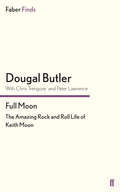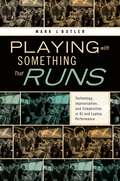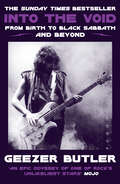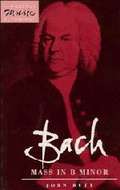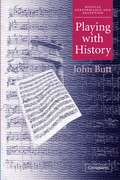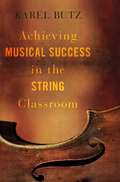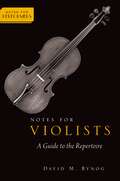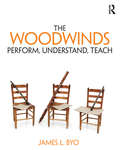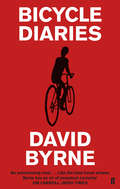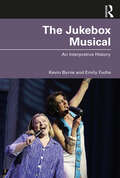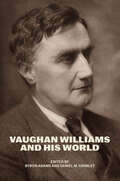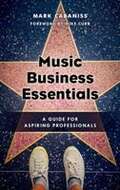- Table View
- List View
Full Moon: The Amazing Rock and Roll Life of Keith Moon
by Dougal ButlerWith Chris Trengove and Peter LawrenceIn 1967 Peter 'Dougal' Butler became a roadie for The Who and their mercurial genius drummer Keith Moon. Soon he would be Moon's personal assistant, chauffeur, and all-purpose wingman. The ride lasted a tumultuous ten years, ending just prior to Moon's untimely death in 1978. Full Moon is Butler's memoir of that ride: essential reading for Who fans, and a masterclass in the mayhem caused by rock 'n' roll excess. 'The most candid insight into the Who star's life.' Daily Star 'Written in a wonderful fast, racy style, Runyonesque and full of good jokes.' Girl About Town 'A welcome change from the usual bland rock book reportage... Butler clearly has a deep and lasting affection for Moon.' Andy Gill, NME 'Certainly outrageous, sometimes funny, but mostly a sad account of life with a talented neurotic.' Daily Mirror
Electronica, Dance and Club Music
by Mark J. ButlerDiscos, clubs and raves have been focal points for the development of new and distinctive musical and cultural practices over the past four decades. This volume presents the rich array of scholarship that has sprung up in response. Cutting-edge perspectives from a broad range of academic disciplines reveal the complex questions provoked by this musical tradition. Issues considered include aesthetics; agency; 'the body' in dance, movement, and space; composition; identity (including gender, sexuality, race, and other constructs); musical design; place; pleasure; policing and moral panics; production techniques such as sampling; spirituality and religion; sub-cultural affiliations and distinctions; and technology. The essays are contributed by an international group of scholars and cover a geographically and culturally diverse array of musical scenes.
Playing with Something That Runs: Technology, Improvisation, and Composition in DJ and Laptop Performance
by Mark J. ButlerWinner of the 2015 PMIG Outstanding Publication Award from the Society of Music Theory The DJs and laptop performers of electronic dance music use preexistent elements such as vinyl records and digital samples to create fluid, dynamic performances. These performances are also largely improvised, evolving in response to the demands of a particular situation through interaction with a dancing audience. Within performance, musicians make numerous spontaneous decisions about variables such as which sounds they will play, when they will play them, and how they will be combined with other sounds. Yet the elements that constitute these improvisations are also fixed in certain fundamental ways: performances are fashioned from patterns or tracks recorded beforehand, and in the case of DJ sets, these elements are also physical objects (vinyl records). In Playing with Something That Runs, author Mark J. Butler explores these improvised performances, revealing the ways in which musicians utilize seemingly invariable prerecorded elements to create novel improvisations. Based on extensive interviews with musicians in their studios, as well as in-depth studies of particular mediums of performance, including both DJ and laptop sets, Butler illustrates the ways in which technologies, both material and musical, are used in performance and improvisation in order to make these transformations possible. An illuminating look at the world of popular electronic-music performance, Playing with Something that Runs is an indispensable resource for electronic dance musicians and fans as well as scholars and students of popular music.
Playing with Something That Runs: Technology, Improvisation, and Composition in DJ and Laptop Performance
by Mark J. ButlerWinner of the 2015 PMIG Outstanding Publication Award from the Society of Music Theory The DJs and laptop performers of electronic dance music use preexistent elements such as vinyl records and digital samples to create fluid, dynamic performances. These performances are also largely improvised, evolving in response to the demands of a particular situation through interaction with a dancing audience. Within performance, musicians make numerous spontaneous decisions about variables such as which sounds they will play, when they will play them, and how they will be combined with other sounds. Yet the elements that constitute these improvisations are also fixed in certain fundamental ways: performances are fashioned from patterns or tracks recorded beforehand, and in the case of DJ sets, these elements are also physical objects (vinyl records). In Playing with Something That Runs, author Mark J. Butler explores these improvised performances, revealing the ways in which musicians utilize seemingly invariable prerecorded elements to create novel improvisations. Based on extensive interviews with musicians in their studios, as well as in-depth studies of particular mediums of performance, including both DJ and laptop sets, Butler illustrates the ways in which technologies, both material and musical, are used in performance and improvisation in order to make these transformations possible. An illuminating look at the world of popular electronic-music performance, Playing with Something that Runs is an indispensable resource for electronic dance musicians and fans as well as scholars and students of popular music.
Electronica, Dance and Club Music
by MarkJ. ButlerDiscos, clubs and raves have been focal points for the development of new and distinctive musical and cultural practices over the past four decades. This volume presents the rich array of scholarship that has sprung up in response. Cutting-edge perspectives from a broad range of academic disciplines reveal the complex questions provoked by this musical tradition. Issues considered include aesthetics; agency; 'the body' in dance, movement, and space; composition; identity (including gender, sexuality, race, and other constructs); musical design; place; pleasure; policing and moral panics; production techniques such as sampling; spirituality and religion; sub-cultural affiliations and distinctions; and technology. The essays are contributed by an international group of scholars and cover a geographically and culturally diverse array of musical scenes.
Into the Void: From Birth to Black Sabbath – and Beyond
by null Geezer ButlerA Rough Trade Book of the Year The Sunday Times bestseller The much-anticipated first book from Black Sabbath bassist Geezer Butler With over 70 million records sold, heavy metal pioneers Black Sabbath are one of the most influential bands of all time. From the very beginning, Geezer Butler was at the heart of their success. He named the group, provided the bass behind their distinctive sound and wrote the lyrics that resonated so powerfully with fans around the world. At long last, Geezer is ready to tell his side of the Sabbath story, from early days as a scrappy blues quartet through to the many lineup changes, the record-breaking tours and the international hell-raising with Ozzy Osbourne, Tony Iommi and Bill Ward. Featuring Geezer’s candid reflections on his working-class childhood in Luftwaffe-battered Birmingham, his almost-life as an accountant and his fascination with horror, religion and the occult, Into the Void reveals the softer side of the heavy metal legend, while holding nothing back. Like Geezer’s bass lines and the story of Black Sabbath themselves, Into the Void is original, dramatic and one hell of a ride.
Bach: Mass In B Minor (PDF)
by John ButtThe Mass in B Minor is arguably Bach's greatest single work. In this short guide John Butt considers the work from many angles offering the reader basic information in a concise and accessible form. The Mass in B Minor is fraught with difficulties regarding its origin, and ambiguities concerning its function. John Butt looks again at the historical sources and provides an up-to-date summary of existing research and opinions together with new insights of his own. He gives a vivid account of the work's genesis, its historical context, and its reception by later generations. One chapter considers the work movement by movement providing the text in both Latin and English. The final group of chapters on the music itself suggests some new approaches to the work - its forms, style and overall structure - which are both critically and historically based. This is an informative and lucid guide, valuable for student and music lover alike. 9780521387163
Playing With History: The Historical Approach To Musical Performance (PDF) (Musical Performance And Reception Ser.)
by John Butt Laurence DreyfusWhy do we feel the need to perform music in a historically informed style? Is this need related to wider cultural concerns? In this study, John Butt sums up debates on the nature of the early music movement and historically informed performance, calling upon a seemingly inexhaustible fund of ideas gleaned from historical musicology, analytic philosophy, literary theory, historiography and theories of modernism and postmodernism. He develops the critical views of both supporters and detractors of the movement, while claiming ultimately that it has more intellectual and artistic potential than its detractors may have assumed. He also asks whether the phenomenon of historically informed performance reflects changes in the culture of western music and how it, in turn, may have influenced that culture, particularly in regard to such issues as the status of the composer, the work, intentionality and notation.
ACHIEV MUSIC SUCCESS IN STRING CLASSR C
by Karel ButzAchieving Musical Success in the String Classroom describes a fully pragmatic pedagogical approach toward developing complete musicianship in beginning through advanced level string players by incorporating the ideas of Mimi Zweig, Paul Rolland, and Shinichi Suzuki. Author Karel Butz's philosophical assumptions are explained regarding the structure and purpose of string teaching contributing to a high level of musical artistry among students. Introductory through advanced string concepts relating to instrument set-up, posture, left and right hand development, music theory, aural skills, assessment procedures, imagery in playing, the development individual practice and ensemble skills, and effective rehearsal strategies are explained in a sequential approach that benefit the classroom teacher and student. In addition, several score examples, sample lesson plans, grading rubrics as well as videos of Butz demonstrating his pedagogical ideas and techniques with musicians are included.
Achieving Musical Success in the String Classroom
by Karel ButzAchieving Musical Success in the String Classroom describes a fully pragmatic pedagogical approach toward developing complete musicianship in beginning through advanced level string players by incorporating the ideas of Mimi Zweig, Paul Rolland, and Shinichi Suzuki. Author Karel Butz's philosophical assumptions are explained regarding the structure and purpose of string teaching contributing to a high level of musical artistry among students. Introductory through advanced string concepts relating to instrument set-up, posture, left and right hand development, music theory, aural skills, assessment procedures, imagery in playing, the development individual practice and ensemble skills, and effective rehearsal strategies are explained in a sequential approach that benefit the classroom teacher and student. In addition, several score examples, sample lesson plans, grading rubrics as well as videos of Butz demonstrating his pedagogical ideas and techniques with musicians are included.
Edinburgh's Greatest Hits: A Celebration of the Capital's Music History
by Jim Byers Jonathan Trew Fiona ShepherdExplore Edinburgh's hidden music heritage, plus a few of its more tuneful tall tales, with this eye-opening guide of the city's music milestones, famous gigs, infamous incidents and colourful characters. From folk to funk, pop to punk and past to present, this collection of bite-sized stories traces the people, venues and gigs that made the city's music scene. From Bowie to the Bay City Rollers, Edinburgh's Greatest Hits touches on the big names as well as lifting the lid on the city's lesser known legends.And just who did leave their teeth in a yoghurt pot on the bar in Sandy Bell's?
Notes for Violists: A Guide to the Repertoire (Notes for Performers)
by David M. BynogNotes for Violists: A Guide to the Repertoire offers historical and analytical information about thirty-five of the best-known pieces for the instrument, making it an essential resource for professional, amateur, and student violists alike. With engaging prose supported by fact-filled analytical charts, the book offers rich biographical information and insightful analyses that help violists gain a more complete understanding of pieces like Béla Bartók's Concerto for Viola and Orchestra, Rebecca Clarke's Sonata for Viola and Piano, Robert Schumann's Märchenbilder for Viola and Piano, op. 113, Carl Stamitz's Concerto for Viola and Orchestra in D Major, Igor Stravinsky's Élégie for Viola or Violin Unaccompanied, and thirty other masterpieces. This comprehensive guide to key pieces from the viola repertoire from the eighteenth through the twentieth century covers concertos, chamber pieces, and works for solo viola by a wide range of composers, including Bach, Telemann, Mozart, Hoffmeister, Walton, and Hindemith. Author David M. Bynog not only offers clear structural analyses of these compositions but also situates them in their historical contexts as he highlights crucial biographical information on composers and explores the circumstances of the development and performance of each work. By connecting performance studies with scholarship, this indispensable handbook for students and professionals allows readers to gain a more complete picture of each work and encourages them to approach other compositions in a similarly analytical manner.
Notes for Violists: A Guide to the Repertoire (Notes for Performers)
by David M. BynogNotes for Violists: A Guide to the Repertoire offers historical and analytical information about thirty-five of the best-known pieces for the instrument, making it an essential resource for professional, amateur, and student violists alike. With engaging prose supported by fact-filled analytical charts, the book offers rich biographical information and insightful analyses that help violists gain a more complete understanding of pieces like Béla Bartók's Concerto for Viola and Orchestra, Rebecca Clarke's Sonata for Viola and Piano, Robert Schumann's Märchenbilder for Viola and Piano, op. 113, Carl Stamitz's Concerto for Viola and Orchestra in D Major, Igor Stravinsky's Élégie for Viola or Violin Unaccompanied, and thirty other masterpieces. This comprehensive guide to key pieces from the viola repertoire from the eighteenth through the twentieth century covers concertos, chamber pieces, and works for solo viola by a wide range of composers, including Bach, Telemann, Mozart, Hoffmeister, Walton, and Hindemith. Author David M. Bynog not only offers clear structural analyses of these compositions but also situates them in their historical contexts as he highlights crucial biographical information on composers and explores the circumstances of the development and performance of each work. By connecting performance studies with scholarship, this indispensable handbook for students and professionals allows readers to gain a more complete picture of each work and encourages them to approach other compositions in a similarly analytical manner.
The Woodwinds: Perform, Understand, Teach
by James ByoThe Woodwinds: Perform, Understand, Teach provides comprehensive coverage about the woodwind family of musical instruments for prospective instrumental music teachers. What sets this book apart is its focus on how to teach the instruments. Preparing students in the how of teaching is the ultimate goal of the woodwind class and the ultimate goal of this book, which organizes information by its use in teaching beginning instrumentalists. In developing performance and understanding, pre-service teachers are positioned to learn to teach through performance—contrasted with an "old-school" belief that one must first spend much time tediously trying to understand how things work before playing the instruments. The book is organized in three parts: Preliminaries, Teaching the Instruments, and Foundations. Chapters in Teaching the Instruments are organized by instrument (flute, clarinet, saxophone, oboe, bassoon) and, within each instrument, according to how an effective teacher might organize experiences for novice learners. Basic embouchure and air stream are covered first, followed by instrument assembly, then hands and holding. Embouchure coverage returns in greater depth, then articulation, and finally "the mechanism," which includes sections on the instruments of the family, transposition, range, special fingerings, tuning and intonation, and reeds. In Foundations, topics are situated in big picture contexts, calling attention to the broad applicability of information across instruments.
The Woodwinds: Perform, Understand, Teach
by James ByoThe Woodwinds: Perform, Understand, Teach provides comprehensive coverage about the woodwind family of musical instruments for prospective instrumental music teachers. What sets this book apart is its focus on how to teach the instruments. Preparing students in the how of teaching is the ultimate goal of the woodwind class and the ultimate goal of this book, which organizes information by its use in teaching beginning instrumentalists. In developing performance and understanding, pre-service teachers are positioned to learn to teach through performance—contrasted with an "old-school" belief that one must first spend much time tediously trying to understand how things work before playing the instruments. The book is organized in three parts: Preliminaries, Teaching the Instruments, and Foundations. Chapters in Teaching the Instruments are organized by instrument (flute, clarinet, saxophone, oboe, bassoon) and, within each instrument, according to how an effective teacher might organize experiences for novice learners. Basic embouchure and air stream are covered first, followed by instrument assembly, then hands and holding. Embouchure coverage returns in greater depth, then articulation, and finally "the mechanism," which includes sections on the instruments of the family, transposition, range, special fingerings, tuning and intonation, and reeds. In Foundations, topics are situated in big picture contexts, calling attention to the broad applicability of information across instruments.
Bicycle Diaries
by David ByrneSince the early 1980s, David Byrne has been riding a bicycle as his principal means of transportation in New York City. A few years later he discovered folding bikes, and starting taking them with him on music tour overseas, and experienced a sense of liberation as he pedalled around many of the world's principal cities. The view from his bike seat has given Byrne a panoramic window on urban life over the last thirty years as he has cycled round cities such as London, Berlin, Buenos Aires, Istanbul, Manila, New York, Detroit and San Francisco. From music and the visual arts, to globalisation, politics, the nature of creative work, fashion and art, this book gives the reader an incredible insight into what Byrne is seeing and thinking as he pedals around these cities.Filled with intimate photographs, incredible musical stories and a powerful ecological message, this is an enchanting celebration of bike riding and of the rewards of seeing the world at bike level. David Byrne is a co-founding member of the musical group Talking Heads. He has produced many solo albums and collaborated with such noted artists as Twyla Tharp, Robert Wilson and Brian Eno. He has received Grammy, Oscar and Golden Globe awards and was inducted into the Rock and Roll Hall of Fame in 2002.
How Music Works
by David ByrneHow Music Works is David Byrne's buoyant celebration of a subject he has spent a lifetime thinking about. Equal parts historian and anthropologist, raconteur and social scientist, Byrne draws on his own work over the years with Talking Heads, Brian Eno, and his myriad collaborators - along with journeys to Wagnerian opera houses, African villages, and anywhere music exists - to show that music-making is not just the act of a solitary composer in a studio, but rather a logical, populist, and beautiful result of cultural circumstance. A brainy, irresistible adventure, How Music Works is an impassioned argument about music's liberating, life-affirming power.
The Jukebox Musical: An Interpretive History
by Kevin Byrne Emily FuchsThis is a comprehensive guide to the unique genre of the jukebox musical, delving into its history to explain why these musicals have quickly become beloved for multiple generations of theatergoers and practitioners. Providing a concise exploration of the three main categories of the jukebox musical—biographical, genre-specific, and artist catalog—this text is perfect for those wishing to learn more about this relatively recent and unique genre of theater. It identifies the dramaturgical needs that arise in these productions and explains how certain works become critical darlings or fan favorites. How much information needs to be conveyed through song and how much can be left up to interpretation by the audience? What kinds of changes occur when a repertoire of songs is reimagined for the stage? In addition to these insightful explorations, it also reveals how creative teams tackle the unique challenge of weaving together plot and song in order to convey meaning, emotion, excitement, and beauty in these increasingly popular forms of theater. The Jukebox Musical: An Interpretive History is written for students, performers, and musical theater enthusiasts alike: this is the ideal introduction to one of the twnty-first century's most popular and successful stage genres.
The Jukebox Musical: An Interpretive History
by Kevin Byrne Emily FuchsThis is a comprehensive guide to the unique genre of the jukebox musical, delving into its history to explain why these musicals have quickly become beloved for multiple generations of theatergoers and practitioners. Providing a concise exploration of the three main categories of the jukebox musical—biographical, genre-specific, and artist catalog—this text is perfect for those wishing to learn more about this relatively recent and unique genre of theater. It identifies the dramaturgical needs that arise in these productions and explains how certain works become critical darlings or fan favorites. How much information needs to be conveyed through song and how much can be left up to interpretation by the audience? What kinds of changes occur when a repertoire of songs is reimagined for the stage? In addition to these insightful explorations, it also reveals how creative teams tackle the unique challenge of weaving together plot and song in order to convey meaning, emotion, excitement, and beauty in these increasingly popular forms of theater. The Jukebox Musical: An Interpretive History is written for students, performers, and musical theater enthusiasts alike: this is the ideal introduction to one of the twnty-first century's most popular and successful stage genres.
Vaughan Williams and His World (The Bard Music Festival)
by Byron Adams and Daniel M. GrimleyA biography of Ralph Vaughan Williams, published in collaboration with the Bard Music Festival. Ralph Vaughan Williams (1872–1958) was one of the most innovative and creative figures in twentieth-century music, whose symphonies stand alongside those of Sibelius, Nielsen, Shostakovich, and Roussel. After his death, shifting priorities in the music world led to a period of critical neglect. What could not have been foreseen is that by the second decade of the twenty-first century, a handful of Vaughan Williams’s scores would attain immense popularity worldwide. Yet the present renown of these pieces has led to misapprehension about the nature of Vaughan Williams’s cultural nationalism and a distorted view of his international cultural and musical significance. Vaughan Williams and His World traces the composer’s stylistic and aesthetic development in a broadly chronological fashion, reappraising Vaughan Williams’s music composed during and after the Second World War and affirming his status as an artist whose leftist political convictions pervaded his life and music. This volume reclaims Vaughan Williams’s deeply held progressive ethical and democratic convictions while celebrating his achievements as a composer.
Hooks in Popular Music
by Tim Byron Jadey O’ReganThis volume is the first book-length study of hooks in popular music. Hooks - those memorable musical moments for listeners such as a riff or catchy melodic phrase – are arguably the guiding principle of much modern popular music. The concept of the hook involves aspects of melody, rhythm, harmony, production, lyrical and cultural meaning - and how these interact within a song’s topline and backing track. Hooks are also inherently related to the human capacities for memory and attention, and interact with our previous experiences with music. Understanding hooks in popular music requires a new interdisciplinary approach drawing from popular music studies, pop musicology, and music psychology, and this book draws from each of these disciplines to understand the hooks present in a broad range of popular music styles from the last thirty years.
The Economics of the Popular Music Industry: Modelling from Microeconomic Theory and Industrial Organization
by C. ByunThis Palgrave Pivot uses modeling from microeconomic theory and industrial organization to demonstrate how consumers and producers have responded to major changes in the music industry. Byun examines the important role of technology in changing its structure, particularly as new methods of creating and accessing music prove to be a double-edged sword for creators and producers. An underlying theme in the project is the question of how the business of music affects creativity, and how artists continue to produce creative output in the face of business pressures, the erosion of copyright enforcement, and rampant online piracy. In addition to being a useful resource for economists interested in the music industry, this approachable Pivot is also ideal for business and music majors studying the effect of technology on their chosen fields.
The Economics of the Popular Music Industry: Modelling from Microeconomic Theory and Industrial Organization
by Christie ByunThis book uses economic theory to explain how consumers and producers have responded to major changes in the music industry. Byun examines the important role of technology in changing its structure, particularly as new methods of creating and accessing music prove to be a double-edged sword for creators and producers. This second edition includes new information about concert attendance and live performance in the COVID era and what followed, as well as the resultant economic impacts on the industry. Throughout the book, Byun questions how the business of music affects creativity and the extent to which this impacts the creative output of the individual artist. Chapters also address copyright enforcement and online piracy. This is an approachable resource for economists interested in the music industry as well as business and music majors studying the ways in which technology can impact a creative process.
Who I Am: My Story THE SUNDAY TIMES BESTSELLER
by Melanie CFor the first time ever, Melanie C, aka Sporty Spice, tells her amazing life story in her own words and gives a full and honest account of what life was really like in The Spice Girls. THE SUNDAY TIMES BESTSELLER ___________'What a woman and what a book!' Elizabeth Day'Fabulous ... There is so much I really relate to, growing up as a young girl, the 90s, all the stuff you went through.' Zoe Ball'Amazing ... Absolutely brilliant.' Chris Evans'Sporty Spice telling it like it is.' Independent'An amazing story ... An incredibly profound, vulnerable and honest look into the highs and lows of the Spice Girls.' Steven Bartlett'Really lovely.' Chris Moyles ___________For the first time ever, Melanie C, aka Sporty Spice, tells her amazing life story in her own words and gives a full and honest account of what life was really like in The Spice Girls.I never told my story before because I wasn't ready. Now, finally, I am.25 years ago, The Spice Girls, a girlband that began after answering an advert in the paper, released our first single. 'Wannabe' became a hit and from that moment, my life changed for ever.I was suddenly part of one of the biggest music groups in history, releasing hit after hit, performing to our wonderful fans and spreading the message of Girl Power to the world. It was everything I'd dreamed of growing up, and I've had some incredible times... The BRITs! The movie! Travelling the world playing iconic venues like Madison Square Garden, The O2, Wembley Stadium and The London 2012 Olympics!!!When you're a woman, though, that power can be easily taken away by those around you, whether by pressure, exhaustion, shaming, bullying or a constant feeling like you aren't enough. I have been known as Sporty Spice, Mel C, Melanie C or just plain old Melanie Chisholm, but what you will read within the pages of this book is who I truly am, and how I found peace with that after all these years.I have really enjoyed reminiscing and getting everything down on the page, and, though revisiting some of my darkest times was hard, I hope this book can be inspiring and empowering as well as entertaining and give you a bit of a laugh.
Music Business Essentials (PDF): A Guide for Aspiring Professionals
by Mark Cabaniss Mike CurbToday's music business is more challenging than ever, but music's availability and the consumption of this powerful force offer unprecedented opportunities for those with the desire to succeed. Music Business Essentials: A Guide for Aspiring Professionals takes musicians and beginning business students on a journey full of vital nuts and bolts knowledge as well as practical wisdom from a veteran industry professional. Although the dynamic music industry is always changing, Mark Cabaniss's concise and encouraging, yet realistic approach reveals unchanging principles to guide readers towards successful and fulfilling careers in music. From band dynamics and touring to songwriting and publishing and from branding and promotion to record labels and revenue streams, Cabaniss covers the entire music machine from the talent to the tax returns. Music Business Essentials is an easy-to-read introduction that will prove an invaluable handbook for reference time and again. It is ideal for college students, high school students, and anyone interested in a career in music.
